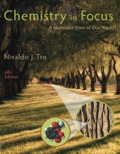
Chemistry In Focus
6th Edition
ISBN: 9781305544727
Author: Tro
Publisher: Cengage
expand_more
expand_more
format_list_bulleted
Concept explainers
Question
Chapter 14, Problem 33E
Interpretation Introduction
Interpretation:
The oxidizing and reducing agents in the photosynthesis reaction are to be identified.
Concept Introduction:
Oxidation is the addition of an electronegative element or the removal of an electropositive element in a
Reduction is the addition of an electropositive element or the removal of an electronegative element in a chemical reaction.
A chemical reaction in which both oxidation and reduction takes place simultaneously is called a
An oxidizing agent is a substance that oxidizes the other substance and gets reduced in a chemical reaction.
A reducing agent is a substance that reduces the other substance and gets oxidized in a chemical reaction.
Expert Solution & Answer
Want to see the full answer?
Check out a sample textbook solution
Students have asked these similar questions
Please predict the products for each of the following
reactions:
1.03
2. H₂O
NaNH,
1. n-BuLi
2. Mel
A
H₂
10
9
0
H2SO4, H₂O
HgSO4
Pd or Pt (catalyst)
B
9
2
n-BuLi
♡
D2 (deuterium)
Lindlar's Catalyst
1. NaNH2
2. EtBr
Na, ND3
(deuterium)
2. H₂O2, NaOH
1. (Sia)2BH
с
D
in the scope of ontario SCH4U grade 12 course, please show ALL work
Is the chemical reaction CuCl42-(green) + 4H2O <==> Cu(H2O)42+(blue) + 4Cl- exothermic or endothermic?
Chapter 14 Solutions
Chemistry In Focus
Ch. 14 - For the following redox reaction, identify the...Ch. 14 - Prob. 14.2YTCh. 14 - Prob. 1SCCh. 14 - What substance is the oxidizing agent in...Ch. 14 - Closely examine Figure 14.1 and explain why no...Ch. 14 - Prob. 1ECh. 14 - Explain the basic principle involved common...Ch. 14 - Prob. 3ECh. 14 - Prob. 4ECh. 14 - Prob. 5E
Ch. 14 - Can an oxidation reaction occur without a...Ch. 14 - Prob. 7ECh. 14 - Why is bromine reduced in the following reaction...Ch. 14 - What is an oxidizing agent? A reducing agent?Ch. 14 - Prob. 10ECh. 14 - Write equations for respiration and...Ch. 14 - Prob. 12ECh. 14 - Prob. 13ECh. 14 - Prob. 14ECh. 14 - Prob. 15ECh. 14 - Give a thermodynamic argument for why it is more...Ch. 14 - Prob. 17ECh. 14 - Use chemical equations to explain how the molten...Ch. 14 - Prob. 19ECh. 14 - Prob. 20ECh. 14 - Prob. 21ECh. 14 - Prob. 22ECh. 14 - Prob. 23ECh. 14 - Prob. 24ECh. 14 - Draw Lewis structures for each chemical reaction,...Ch. 14 - Draw Lewis structures for each chemical reaction,...Ch. 14 - Prob. 27ECh. 14 - For each reaction, indicate which elements are...Ch. 14 - For each reaction, indicate which elements are...Ch. 14 - For each reaction, indicate which elements are...Ch. 14 - For each reaction, identify the oxidizing agent...Ch. 14 - Prob. 32ECh. 14 - Prob. 33ECh. 14 - Prob. 34ECh. 14 - Which would you expect to be a better oxidizing...Ch. 14 - Prob. 36ECh. 14 - Prob. 37ECh. 14 - Sum each of the following oxidation and reduction...Ch. 14 - Prob. 39ECh. 14 - Prob. 40ECh. 14 - Which of the following factors might affect the...Ch. 14 - Prob. 42ECh. 14 - Prob. 43ECh. 14 - Fossil fuel, nuclear, and hydroelectric power...Ch. 14 - The following diagram shows an electrochemical...Ch. 14 - The following diagram shows a molecular view of...
Knowledge Booster
Learn more about
Need a deep-dive on the concept behind this application? Look no further. Learn more about this topic, chemistry and related others by exploring similar questions and additional content below.Similar questions
- If we react tetraethoxypropane with hydrazine, what is the product obtained (explain its formula). State the reason why the corresponding dialdehyde is not used.arrow_forwarddrawing, no aiarrow_forwardIf CH3COCH2CH(OCH3)2 (4,4-dimethoxy-2-butanone) and hydrazine react, two isomeric products are formed. State their structure and which will be the majority.arrow_forward
- + Reset Provide the correct IUPAC name for the compound shown here. 4-methylhept-2-ene (Z)- (E)- 1-6-5-2-3-4- cyclo iso tert- sec- di tri hept hex oct meth eth pent ane yne ene ylarrow_forward+ Provide the correct IUPAC name for the compound shown here. Reset H3C H H C CH3 CH-CH3 1-3-methylpent ene trans- cis- 5-6-3-1-2-4- tert- tri sec- di cyclo iso but pent hex meth prop eth yl ane ene yne ☑arrow_forwarddrawing, no aiarrow_forward
- drawing, no aiarrow_forwardDraw the major organic product when each of the bellow reagents is added to 3,3-dimethylbutere. ✓ 3rd attempt Part 1 (0.3 point) H.C CH CH + 1. BHG THF 210 NaOH NJ 10000 Part 2 (0.3 point) HC- CH HC 2741 OH a Search 1. He|DA HO 2. NIBH さ 士 Ju See Periodic Table See Hint j = uz C H F F boxarrow_forwardSynthesis of 2-metilbenzimidazol from 1,2-diaminobenceno y propanona.arrow_forward
arrow_back_ios
SEE MORE QUESTIONS
arrow_forward_ios
Recommended textbooks for you
- Chemistry: Matter and ChangeChemistryISBN:9780078746376Author:Dinah Zike, Laurel Dingrando, Nicholas Hainen, Cheryl WistromPublisher:Glencoe/McGraw-Hill School Pub Co
 Living By Chemistry: First Edition TextbookChemistryISBN:9781559539418Author:Angelica StacyPublisher:MAC HIGHER
Living By Chemistry: First Edition TextbookChemistryISBN:9781559539418Author:Angelica StacyPublisher:MAC HIGHER World of Chemistry, 3rd editionChemistryISBN:9781133109655Author:Steven S. Zumdahl, Susan L. Zumdahl, Donald J. DeCostePublisher:Brooks / Cole / Cengage Learning
World of Chemistry, 3rd editionChemistryISBN:9781133109655Author:Steven S. Zumdahl, Susan L. Zumdahl, Donald J. DeCostePublisher:Brooks / Cole / Cengage Learning  Chemistry for Today: General, Organic, and Bioche...ChemistryISBN:9781305960060Author:Spencer L. Seager, Michael R. Slabaugh, Maren S. HansenPublisher:Cengage Learning
Chemistry for Today: General, Organic, and Bioche...ChemistryISBN:9781305960060Author:Spencer L. Seager, Michael R. Slabaugh, Maren S. HansenPublisher:Cengage Learning General, Organic, and Biological ChemistryChemistryISBN:9781285853918Author:H. Stephen StokerPublisher:Cengage Learning
General, Organic, and Biological ChemistryChemistryISBN:9781285853918Author:H. Stephen StokerPublisher:Cengage Learning

Chemistry: Matter and Change
Chemistry
ISBN:9780078746376
Author:Dinah Zike, Laurel Dingrando, Nicholas Hainen, Cheryl Wistrom
Publisher:Glencoe/McGraw-Hill School Pub Co

Living By Chemistry: First Edition Textbook
Chemistry
ISBN:9781559539418
Author:Angelica Stacy
Publisher:MAC HIGHER

World of Chemistry, 3rd edition
Chemistry
ISBN:9781133109655
Author:Steven S. Zumdahl, Susan L. Zumdahl, Donald J. DeCoste
Publisher:Brooks / Cole / Cengage Learning

Chemistry for Today: General, Organic, and Bioche...
Chemistry
ISBN:9781305960060
Author:Spencer L. Seager, Michael R. Slabaugh, Maren S. Hansen
Publisher:Cengage Learning


General, Organic, and Biological Chemistry
Chemistry
ISBN:9781285853918
Author:H. Stephen Stoker
Publisher:Cengage Learning